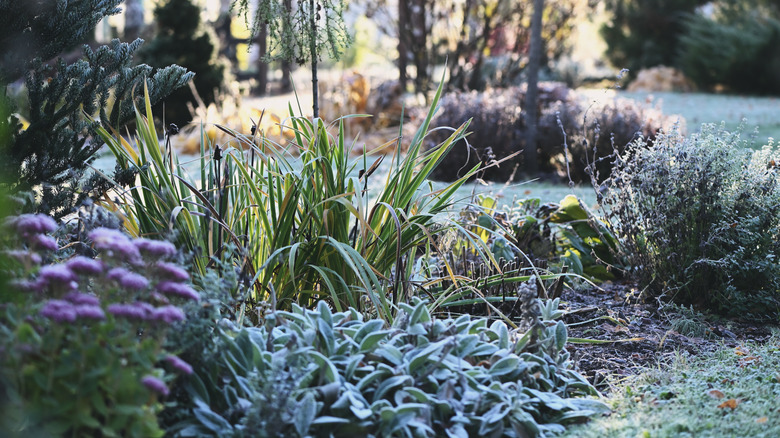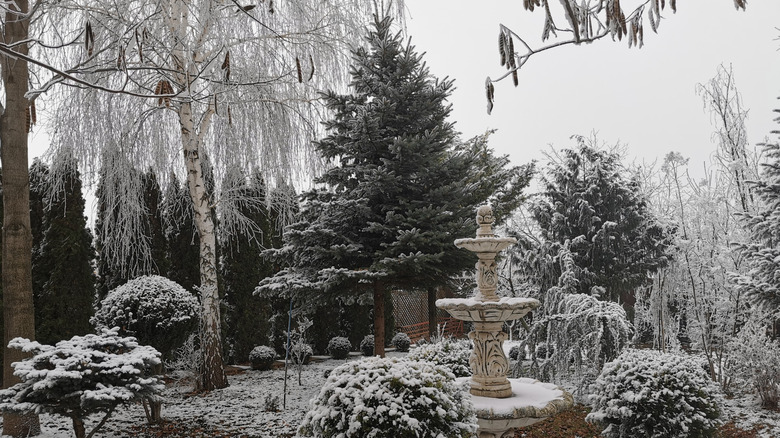Design A Beautiful Garden That Looks Equally Stunning In Winter Weather
Just like Sleeping Beauty of fairy tale fame attracted admirers while she slept, there's no reason for your winter garden to lack interest. With some well-chosen plant combinations and other design tricks, the features in your yard can remain a source of inspiration and beauty for you during the cold months. To get started, choose a palette of plants, including evergreens and ornamental grasses, to keep color and texture alive all year long. Then use a few principles of garden design to create a harmonious landscape.
Choosing plants that are evergreen throughout winter weather keeps greens and blues in your yard to contrast with deciduous trees and shrubs that are dominated by grays and browns. But blues and greens aren't your only choice. Plants that exhibit silver colors during the cold months will blend beautifully with a snowy setting, as do perennials that take on stunning shades of golden, purple, or dark red. An intentional selection among these hues will help set the stage as you incorporate additional features into your garden for year-round interest.
Evergreens and perennials to consider for a winter garden
Be sure to include evergreen conifer trees and shrubs such as pines, spruces, junipers, and firs in your winter garden design since they're gorgeous all year long. You'll increase winter interest if you incorporate a variety of conifers of different shapes and sizes. Don't forget broadleaf evergreens or semi-evergreens — such as wax myrtles (Myrica) — in addition to conifers. Also, there are a surprising number of perennials that stay "awake" during winter, including stonecrops (Sedum), yarrow (Achillea), Christmas fern (Polystichum acrostichoides), and moss phlox (Phlox subulata).
Follow the low-maintenance winter garden trend and leave the faded seed heads from winter-dormant perennials such as coneflowers, both because they are beautiful and since birds use them as food. Consider that some trees and shrubs bring unexpected color to the landscape with their bark, like red twig dogwood (Cornus sericea), which has stunning foliage and bright red bark in winter. And with their fountain-like sprays of foliage, ornamental grasses create a sense of movement year-round. You may also want to incorporate trees that have fruit after autumn, like hollies (Ilex). Growing berry-laden trees and shrubs will light up your outdoor space, as well as attract birds to your yard during the winter season.
Bringing winter plants together with design
In addition to vegetation, consider hardscaping and other decorative elements that will look beautiful dusted with snow and unify the yard, both literally and visually. Walkways such as stepping stones help define spaces and direct the eye, while decorative structures like bird baths and trellises can add vertical layers to your space. Think about the type of style you're aiming for when laying out hardscaping, paths, and borders — arranging them in straight lines creates a more formal feel, while curves look more natural.
Once you have an idea of the garden style you want, choose plants and other elements that are in proportion with your home. For instance, if you grow a towering fir tree next to your ranch home, things will look a bit off. Next, use the rule of three for landscaping your space: Group plantings in odd numbers for a more organic and harmonious effect. Then repeat the same or similar groupings throughout the design to create a sense of unity.
Add texture to your groupings, too. Using combinations of different types of plants — such as three coniferous shrubs that each have a different shape — will create contrasting textures that add visual interest. Finally, notice where your eye gets directed within the landscape and rearrange if necessary. Once you've incorporated these design principles into your yard, your sleeping garden will transform into a living beauty, no matter the season.


